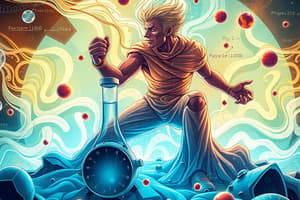Podcast
Questions and Answers
What is matter?
What is matter?
- Only solid substances
- Only gaseous substances
- Only liquid substances
- Anything that has mass and occupies space (correct)
What are atoms?
What are atoms?
Building blocks of matter
What are the states of matter?
What are the states of matter?
Gas, liquid, solid
What is a gas?
What is a gas?
What is a liquid?
What is a liquid?
What is a solid?
What is a solid?
What is a pure substance?
What is a pure substance?
What are compounds?
What are compounds?
What is the law of constant composition?
What is the law of constant composition?
What are mixtures?
What are mixtures?
What are solutions?
What are solutions?
What are physical properties?
What are physical properties?
What are chemical properties?
What are chemical properties?
What are intensive properties?
What are intensive properties?
What are extensive properties?
What are extensive properties?
What is a physical change?
What is a physical change?
What is a chemical change or reaction?
What is a chemical change or reaction?
Which of the following are methods of separation of mixtures? (Select all that apply)
Which of the following are methods of separation of mixtures? (Select all that apply)
What is the scientific method?
What is the scientific method?
What are scientific laws?
What are scientific laws?
What is a hypothesis?
What is a hypothesis?
What is the metric system?
What is the metric system?
What are SI units?
What are SI units?
What is mass?
What is mass?
What is the Celsius scale?
What is the Celsius scale?
What is the Kelvin scale?
What is the Kelvin scale?
What is Fahrenheit?
What is Fahrenheit?
What is volume?
What is volume?
What is density?
What is density?
What is Tera?
What is Tera?
What is Giga?
What is Giga?
What is Mega?
What is Mega?
What is Kilo?
What is Kilo?
What is Hecto?
What is Hecto?
What is Deka?
What is Deka?
What is Deci?
What is Deci?
What is Centi?
What is Centi?
What is Milli?
What is Milli?
What is Micro?
What is Micro?
What is Nano?
What is Nano?
What is Pico?
What is Pico?
What is precision?
What is precision?
What is accuracy?
What is accuracy?
What are significant figures?
What are significant figures?
What are significant figures in calculations?
What are significant figures in calculations?
What is dimensional analysis?
What is dimensional analysis?
What are conversion factors?
What are conversion factors?
Study Notes
Matter and States of Matter
- Matter is defined as anything that has mass and occupies space.
- Atoms are the basic building blocks of matter.
- The three primary states of matter are gas, liquid, and solid.
- A gas has no fixed volume or shape.
- A liquid has a fixed volume but assumes the shape of its container.
- A solid maintains a definite volume and shape.
Pure Substances and Mixtures
- Pure substances have distinct properties and consistent composition across samples.
- Compounds consist of two or more elements chemically bonded together.
- The law of constant composition states that compounds have a uniform elemental composition.
- Mixtures can have variable compositions and can be homogeneous (uniform) or heterogeneous (non-uniform).
Properties of Substances
- Physical properties can be measured without altering the substance's identity.
- Chemical properties describe how a substance may change or react chemically.
- Intensive properties, such as density, do not depend on sample size.
- Extensive properties, like mass and volume, depend on the amount of material present.
Changes in Matter
- Physical changes alter a substance's appearance without changing its composition.
- Chemical changes transform a substance into a different one with different properties.
- Mixtures can be separated via filtration, distillation, or chromatography.
Scientific Principles
- The scientific method is a systematic approach for investigating questions.
- Scientific laws summarize consistent natural behaviors, while hypotheses are tentative explanations leading to theories.
Measurement and Units
- The metric system, especially SI units, is used for scientific measurements.
- Key SI units include the meter (length), kilogram (mass), and second (time).
- Mass measures the amount of material, while volume relates to three-dimensional space occupied.
- Temperature scales include Celsius, Kelvin, and Fahrenheit, with conversions among them (C = (5/9)(F - 32), K = C + 273, F = (9/5)C + 32).
Density and Conversions
- Density is calculated as mass divided by volume.
- Metric prefixes denote scale: Tera (10^12), Giga (10^9), Mega (10^6), Kilo (10^3), Hecto (10^2), Deka (10^1), Deci (10^-1), Centi (10^-2), Milli (10^-3), Micro (10^-6), Nano (10^-9), Pico (10^-12).
Measurement Accuracy and Precision
- Precision measures the consistency of measurements, while accuracy indicates closeness to the true value.
- Significant figures account for all known digits in a measurement, including uncertain ones.
- Rules for significant figures in calculations vary with operations: addition/subtraction aligns decimal places, while multiplication/division relies on the least number of significant figures.
Dimensional Analysis and Conversion Factors
- Dimensional analysis helps track units throughout calculations to ensure correctness.
- Conversion factors are fractions that express the same quantity in different units, aiding in measurement conversions.
Studying That Suits You
Use AI to generate personalized quizzes and flashcards to suit your learning preferences.
Description
Test your knowledge of essential chemistry concepts with these flashcards covering Chapters 1-4 of AP Chemistry. Each card features important terms and definitions to help reinforce your understanding of matter, atoms, and states of matter.




